Unit 4 Then and now 复习课件(共25张PPT)
文档属性
| 名称 | Unit 4 Then and now 复习课件(共25张PPT) | 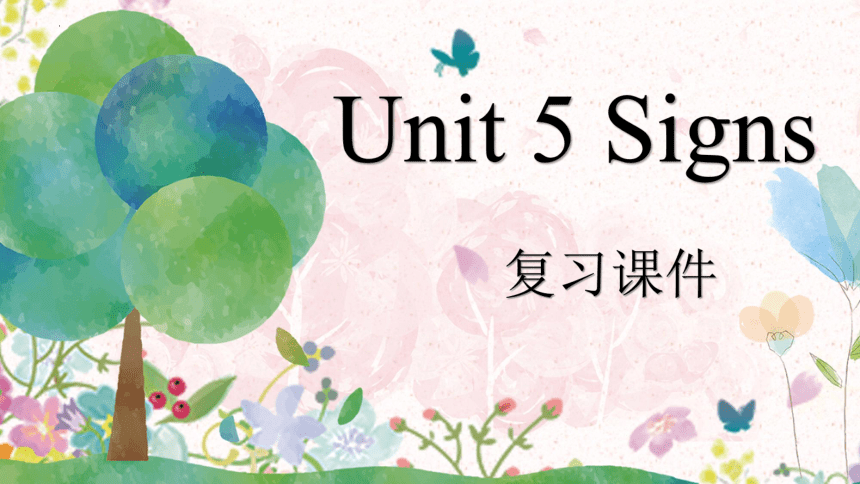 | |
| 格式 | pptx | ||
| 文件大小 | 15.4MB | ||
| 资源类型 | 试卷 | ||
| 版本资源 | 牛津译林版 | ||
| 科目 | 英语 | ||
| 更新时间 | 2023-12-26 17:03:30 | ||
图片预览

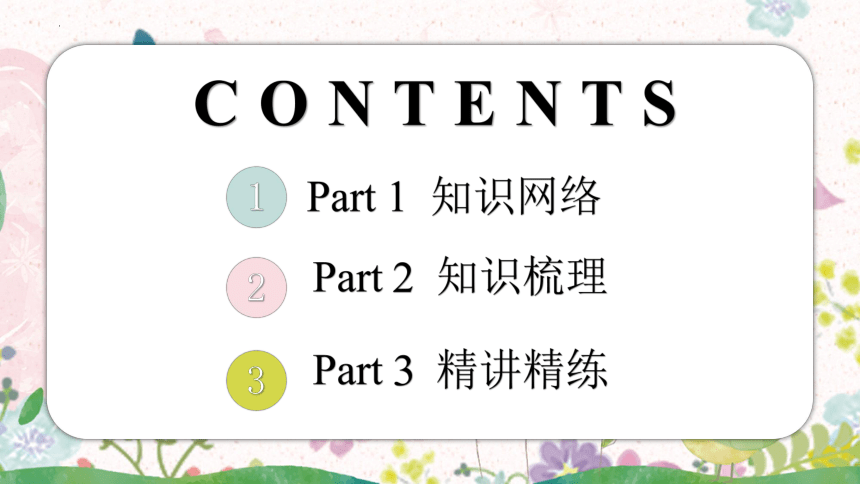
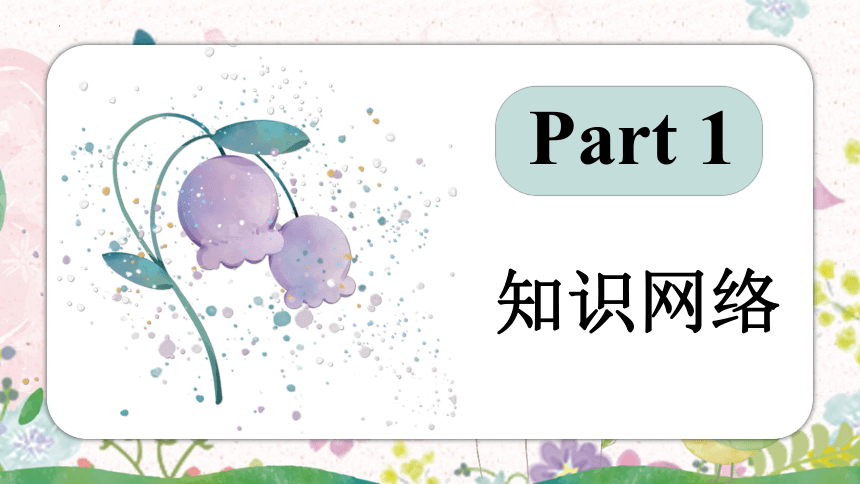
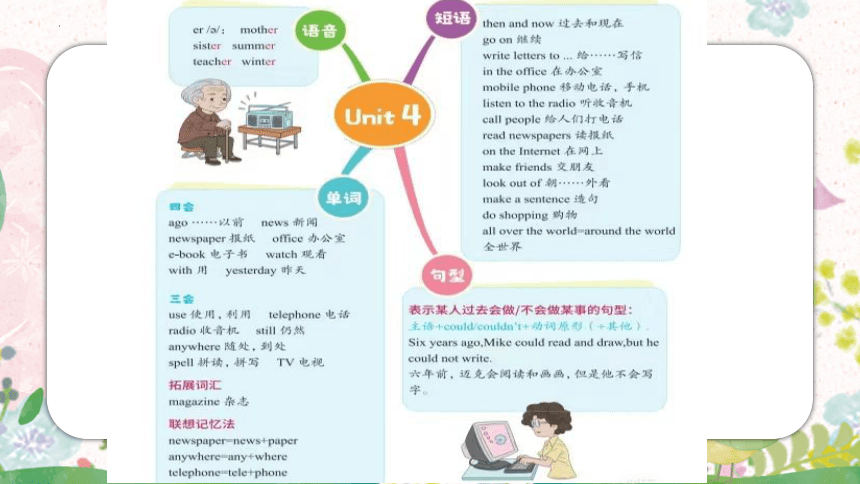
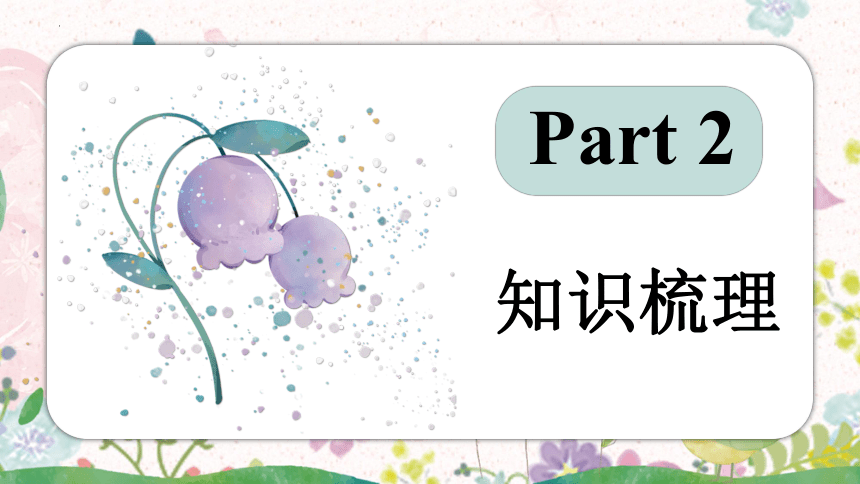


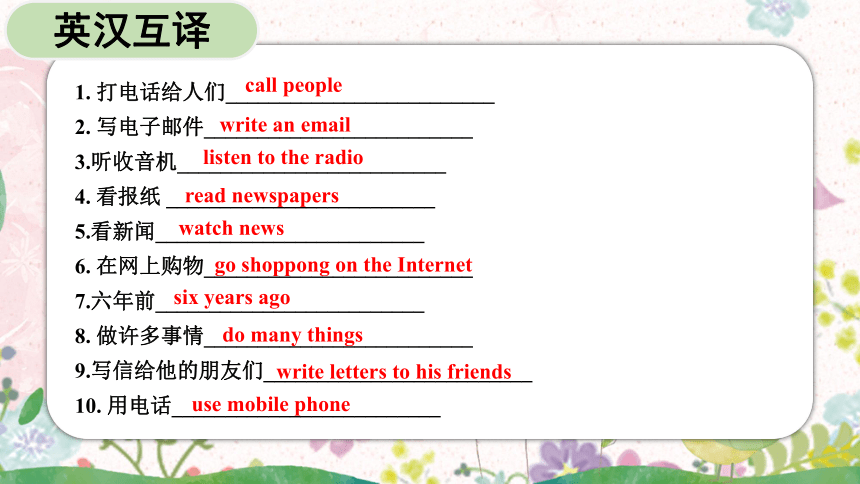
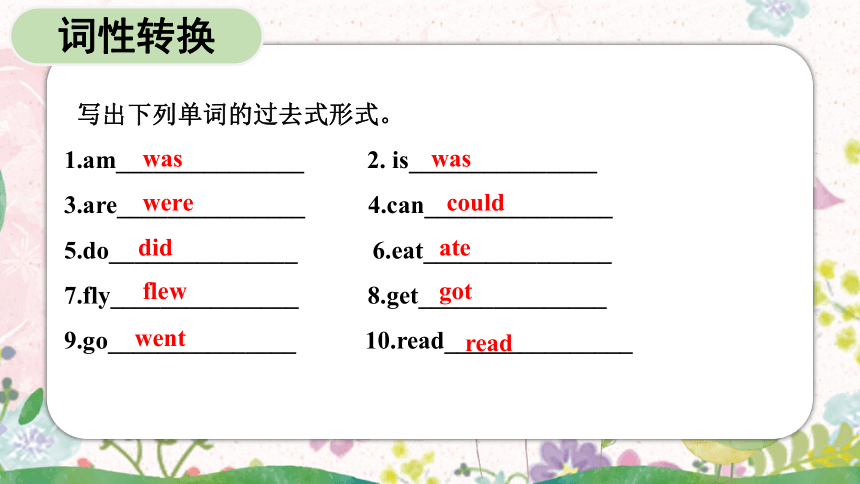
文档简介
(共25张PPT)
Unit 5 Signs
复习课件
C O N T E N T S
Part 1 知识网络
1
Part 3 精讲精练
3
Part 2 知识梳理
2
Part 1
知识网络
Part 2
知识梳理
docerID:327037375
Vocabulary
Sentence
patterns
Practise
词汇
句型
练习
Let's read
newspaper
ago
radio
telephone
news
office
use
mobile phone
careful
anywhere
英汉互译
1. 打电话给人们_________________________
2. 写电子邮件_________________________
3.听收音机_________________________
4. 看报纸 _________________________
5.看新闻_________________________
6. 在网上购物_________________________
7.六年前_________________________
8. 做许多事情_________________________
9.写信给他的朋友们_________________________
10. 用电话_________________________
call people
write an email
go shoppong on the Internet
listen to the radio
watch news
six years ago
read newspapers
do many things
write letters to his friends
use mobile phone
词性转换
写出下列单词的过去式形式。
1.am_______________ 2. is_______________
3.are_______________ 4.can_______________
5.do_______________ 6.eat_______________
7.fly_______________ 8.get_______________
9.go_______________ 10.read_______________
could
did
was
were
was
ate
flew
got
went
read
根据所给词的适当形式填空。
1. He________(make) a model plane yesterday.
2. I’d like________(play) basketball with my friends.
3. Mike________(eat) some fish yesterday morning.
4. Shall we________(start) our English lesson
5. ________(be) Jack at school last Friday
start
Was
made
ate
to play
根据首字母完成句子。
1.Ten years a , Internet wasn’t popular.
2.I bought a m p last week. I can call my friends
anywhere.
3.Mr Green was in the teachers’ o .
4.Can you a my question
5.After the break(休息), our English lesson g on.
6.The British invented the t .
7.—Can you s the word “Wednesday”
nswer
ffice
go
obile
hone
oes
rain
pell
Part 3
精讲精练
知识点01:原句:Six years ago, Mike could read and draw, but he could not write.六年前,迈克会读书和画画,但是他不会写字。
【语法解析】
·could是can的过去式,意为“能够,会,可以”,表示某人具有做某事的能力;
其否定形式为couldn’t =could not;
·两者没有人称和数的变化,其后都要接动词原形。即
can/could + 动词原形
·肯定句型结构:主语 + could + 动词原形(+其他).
否定句型结构:主语 + couldn’t + 动词原形(+其他).
一般疑问句结构:Could + 主语 + 动词原形(+其他)?
肯定回答:Yes, 主语+could./否定回答:No, 主语+couldn’t.
拓展:could也可以表示委婉、客气地提出问题或陈述看法,此时可以与can互换使用,但could的语气较can委婉,两者没有时态上的区别。
例如: When I was five years old, I could sing, but I couldn’t dance.
【牛刀小试】
一、用can或could的正确形式填空。
1.He swim and I sing.
2.She read and draw, but she write five years ago.
3.LiuTao play basketball when(当) he was a child.
can
can
can
could
could
知识点02:原句:He used the telephone at home and in the office to call people.他用家里和办公室的电话机给人打电话。
【语法解析】
(1)考点:use sth. to do sth. 用......做
= do sth. with sth.
例如:We use water to wash hands.我们用水洗手。
=We wash hands with water.
(2)【拓展】use和with都有用的意思,use是动词,with是介词,用法不同
“和” I played football with my brother last Sunday.
with的用法: “长着” The boy with a big nose is my brother.
“拥有” I have a new house with a big garden.
“用” Make a sentence with “egg”.
注:句中有谓语动词时,选介词“with”表示用,句中无谓语动词时,选动词“use”。
【牛刀小试】
一、用所给词的适当形式填空。
1.Mr White (use) the telephone (call) people twenty years ago.
2.My father (use) a mobile phone (call) (I) just now.
3.Who can make a sentence (use/with) this new word
used
to call
called
to call
me
with
知识点03:原句:Mr Brown wrote letters to his friends.
布朗先生给他的朋友们写信。
【语法解析】
(1)考点:write sb. a letter写信给某人
= write (a letter) to sb.
例如:I often write my e-friends a letter. 我经常写信给我的网友。
=I often write a letter to my e-friends.
注:write的过去式是wrote
【牛刀小试】
1.翻译:我的妈妈十年前写信给她的朋友。
______________________________________________________
( )2. Mr Green is writing a letter his friend the office.
A.to; at B.for; in C.to; in
( )3. --What did you do yesterday --I a letter at home.
A.writed B.am writing C.wrote
My mother wrote letters to her friends ten years ago.
C
C
知识点04:某国人的名词复数
【语法解析】
一起来观察总结吧:
Chinese--Chinese中国人 Japanese--Japanese日本人 Swiss--Swiss瑞士人
Englishman--Englishmen英国人 Frenchman--Frenchmen法国人
American--Americans美国人 German--Germans德国人
总结: 中日不变,英法变,其他国人加s
【牛刀小试】
一、用所给词的适当形式填空。
( )1.There are four _____ and two ____ in the group.
A.Japanese, Germen B. Japaneses, Germen
C. Japanese, Germans D. Japanese, German
( )2. --Who invented the train -- .
A.Chinese B.Japanese C.British D.Americans
C
C
知识点05:比较:一般过去时VS一般现在时
【语法解析】
1.定义:指经常性或习惯性的动作或存在的状态
若指经常性、习惯性的动作,谓语动词用行为动词;
若指经常性、习惯性的状态,谓语动词用be动词。
2.谓语动词 am/is/are
3.标志词:every day, always, usually, often, sometimes, seldom(很少), never(从不)
4.动词三单变化规则:
(1)一般在动词尾加s,如:look--looks, read--reads;
(2)以s, x, sh, ch以及o结尾的动词加es,如:catch--catches, go--goes, do--does;
(3)以“辅音字母+y”结尾的动词,变y为i,再加es, 如:fly--flies;
(4)特例:have--has
注:当主语是he, she, it以及单数,不可数名词时用三单。
【牛刀小试】
一、单项选择。
( )1. Mike ____ this storybook two days ago.
A. read B. reads C. readed
( )2. I didn’t wear glasses ____. But I must wear a pair of glasses every day now.
A. last year B. next week C. now
( )3. Miss Green usually _____ letters _____ me twenty years ago.
A. writes; to B. writes; for C. wrote; to
A
A
C
知识点06:字母“er”的发音字。
【语法解析】
字母组合er在非重点音节中,尤其是作为后缀时,常发短元音/ /,
如:teacher,worker
拓展:字母组合er在重读闭音节中,常发长元音/ :/,
如:term, her
【牛刀小试】
从下列每组单词中选出画线部分读音不同的一项。
( )1.A.paper B.summer C.term D.worker
C
Thank you
Unit 5 Signs
复习课件
C O N T E N T S
Part 1 知识网络
1
Part 3 精讲精练
3
Part 2 知识梳理
2
Part 1
知识网络
Part 2
知识梳理
docerID:327037375
Vocabulary
Sentence
patterns
Practise
词汇
句型
练习
Let's read
newspaper
ago
radio
telephone
news
office
use
mobile phone
careful
anywhere
英汉互译
1. 打电话给人们_________________________
2. 写电子邮件_________________________
3.听收音机_________________________
4. 看报纸 _________________________
5.看新闻_________________________
6. 在网上购物_________________________
7.六年前_________________________
8. 做许多事情_________________________
9.写信给他的朋友们_________________________
10. 用电话_________________________
call people
write an email
go shoppong on the Internet
listen to the radio
watch news
six years ago
read newspapers
do many things
write letters to his friends
use mobile phone
词性转换
写出下列单词的过去式形式。
1.am_______________ 2. is_______________
3.are_______________ 4.can_______________
5.do_______________ 6.eat_______________
7.fly_______________ 8.get_______________
9.go_______________ 10.read_______________
could
did
was
were
was
ate
flew
got
went
read
根据所给词的适当形式填空。
1. He________(make) a model plane yesterday.
2. I’d like________(play) basketball with my friends.
3. Mike________(eat) some fish yesterday morning.
4. Shall we________(start) our English lesson
5. ________(be) Jack at school last Friday
start
Was
made
ate
to play
根据首字母完成句子。
1.Ten years a , Internet wasn’t popular.
2.I bought a m p last week. I can call my friends
anywhere.
3.Mr Green was in the teachers’ o .
4.Can you a my question
5.After the break(休息), our English lesson g on.
6.The British invented the t .
7.—Can you s the word “Wednesday”
nswer
ffice
go
obile
hone
oes
rain
pell
Part 3
精讲精练
知识点01:原句:Six years ago, Mike could read and draw, but he could not write.六年前,迈克会读书和画画,但是他不会写字。
【语法解析】
·could是can的过去式,意为“能够,会,可以”,表示某人具有做某事的能力;
其否定形式为couldn’t =could not;
·两者没有人称和数的变化,其后都要接动词原形。即
can/could + 动词原形
·肯定句型结构:主语 + could + 动词原形(+其他).
否定句型结构:主语 + couldn’t + 动词原形(+其他).
一般疑问句结构:Could + 主语 + 动词原形(+其他)?
肯定回答:Yes, 主语+could./否定回答:No, 主语+couldn’t.
拓展:could也可以表示委婉、客气地提出问题或陈述看法,此时可以与can互换使用,但could的语气较can委婉,两者没有时态上的区别。
例如: When I was five years old, I could sing, but I couldn’t dance.
【牛刀小试】
一、用can或could的正确形式填空。
1.He swim and I sing.
2.She read and draw, but she write five years ago.
3.LiuTao play basketball when(当) he was a child.
can
can
can
could
could
知识点02:原句:He used the telephone at home and in the office to call people.他用家里和办公室的电话机给人打电话。
【语法解析】
(1)考点:use sth. to do sth. 用......做
= do sth. with sth.
例如:We use water to wash hands.我们用水洗手。
=We wash hands with water.
(2)【拓展】use和with都有用的意思,use是动词,with是介词,用法不同
“和” I played football with my brother last Sunday.
with的用法: “长着” The boy with a big nose is my brother.
“拥有” I have a new house with a big garden.
“用” Make a sentence with “egg”.
注:句中有谓语动词时,选介词“with”表示用,句中无谓语动词时,选动词“use”。
【牛刀小试】
一、用所给词的适当形式填空。
1.Mr White (use) the telephone (call) people twenty years ago.
2.My father (use) a mobile phone (call) (I) just now.
3.Who can make a sentence (use/with) this new word
used
to call
called
to call
me
with
知识点03:原句:Mr Brown wrote letters to his friends.
布朗先生给他的朋友们写信。
【语法解析】
(1)考点:write sb. a letter写信给某人
= write (a letter) to sb.
例如:I often write my e-friends a letter. 我经常写信给我的网友。
=I often write a letter to my e-friends.
注:write的过去式是wrote
【牛刀小试】
1.翻译:我的妈妈十年前写信给她的朋友。
______________________________________________________
( )2. Mr Green is writing a letter his friend the office.
A.to; at B.for; in C.to; in
( )3. --What did you do yesterday --I a letter at home.
A.writed B.am writing C.wrote
My mother wrote letters to her friends ten years ago.
C
C
知识点04:某国人的名词复数
【语法解析】
一起来观察总结吧:
Chinese--Chinese中国人 Japanese--Japanese日本人 Swiss--Swiss瑞士人
Englishman--Englishmen英国人 Frenchman--Frenchmen法国人
American--Americans美国人 German--Germans德国人
总结: 中日不变,英法变,其他国人加s
【牛刀小试】
一、用所给词的适当形式填空。
( )1.There are four _____ and two ____ in the group.
A.Japanese, Germen B. Japaneses, Germen
C. Japanese, Germans D. Japanese, German
( )2. --Who invented the train -- .
A.Chinese B.Japanese C.British D.Americans
C
C
知识点05:比较:一般过去时VS一般现在时
【语法解析】
1.定义:指经常性或习惯性的动作或存在的状态
若指经常性、习惯性的动作,谓语动词用行为动词;
若指经常性、习惯性的状态,谓语动词用be动词。
2.谓语动词 am/is/are
3.标志词:every day, always, usually, often, sometimes, seldom(很少), never(从不)
4.动词三单变化规则:
(1)一般在动词尾加s,如:look--looks, read--reads;
(2)以s, x, sh, ch以及o结尾的动词加es,如:catch--catches, go--goes, do--does;
(3)以“辅音字母+y”结尾的动词,变y为i,再加es, 如:fly--flies;
(4)特例:have--has
注:当主语是he, she, it以及单数,不可数名词时用三单。
【牛刀小试】
一、单项选择。
( )1. Mike ____ this storybook two days ago.
A. read B. reads C. readed
( )2. I didn’t wear glasses ____. But I must wear a pair of glasses every day now.
A. last year B. next week C. now
( )3. Miss Green usually _____ letters _____ me twenty years ago.
A. writes; to B. writes; for C. wrote; to
A
A
C
知识点06:字母“er”的发音字。
【语法解析】
字母组合er在非重点音节中,尤其是作为后缀时,常发短元音/ /,
如:teacher,worker
拓展:字母组合er在重读闭音节中,常发长元音/ :/,
如:term, her
【牛刀小试】
从下列每组单词中选出画线部分读音不同的一项。
( )1.A.paper B.summer C.term D.worker
C
Thank you
